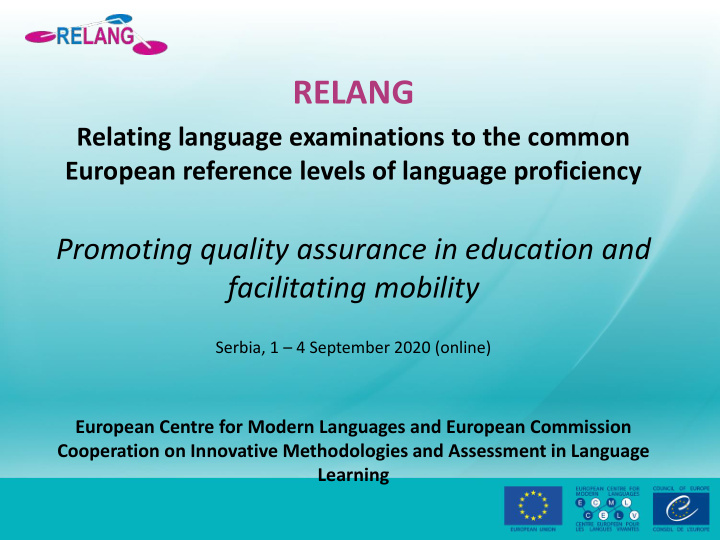



RELANG Relating language examinations to the common European reference levels of language proficiency Promoting quality assurance in education and facilitating mobility Serbia, 1 – 4 September 2020 (online) European Centre for Modern Languages and European Commission Cooperation on Innovative Methodologies and Assessment in Language Learning
RELANG Team Members • Éveline Bérard: (formerly) Université de Franche-Comté, Centre de linguistique appliquée, France • Jana Bé rešová: Trnava University, Slovak Republic • Rita Juknevičienė : Vilnius University, Lithuania • José Noijons: (formerly) Cito, Institute for Educational Measurement, The Netherlands (Coordinator) • Gábor Szabó : University of Pécs, Hungary
Basic Documentation Four Council of Europe / ECML publications on the construction and validation of language tests linked to the CEFR: • Common European Framework of Reference for Languages: Learning, Teaching, Assessment (CEFR) • Companion Volume to the CEFR • The ALTE Manual for Language Test Development and Examining • Relating Language Examinations to the Common European Framework of Reference for Languages: Learning, Teaching, Assessment (CEFR): Highlights
Linking Procedures in the Manual • Familiarisation with the CEFR • Linking on the basis of specification of examination content • Standardization and Benchmarking • Standard setting • Validation: checking that exam results relate to CEFR levels as intended
The CEFR Model of Language Use Action-oriented approach: • Actions performed by persons - individuals and social agents • A range of competences – general – communicative language competences • Various contexts under various conditions and constraints to engage in language activities • Language processes to produce and/or receive texts in relation to themes in specific domains
The user/ learner’s Competences
Language use and the user/learner
Companion Volume (CV) CV is an update of the CEFR illustrative descriptors by: • highlighting CEFR areas for which no descriptor scales had yet been provided, especially mediation and plurilingual/pluricultural competence. • Extended definition of ‘plus levels’ and a new ‘Pre - A1’ level. • More elaborate description of listening and reading in existing scales, and for descriptors for activities such as online interaction, using telecommunications, expressing reactions to creative text and literature. • enriching the description at A1, and at the C levels, particularly C2.
What is Validity? • A test is valid if it measures what we intend it to measure. • Definition extended to the way tests are used, i.e. the interpretations of test scores
Validity and the CEFR • Demonstrating that a learner reported to be at B1 actually is at B1 according to the evidence • Focus on use: validity evidence relates to language used for communicative purposes • Focus on competence: validity evidence relates to cognitive skills, strategies and language knowledge
What is Reliability? • Reliability in testing means consistency – same or similar results on repeated use • High reliability does not mean the test is valid
Reliability in Practice • Minimising likely sources of error • Using statistics to estimate reliability of test scores • No reliability target for the scores of all tests: estimates dependent on how much scores vary • Reliability depends on task type and way of marking
Fairness • Making the test as fair as possible • Codes of Practice or Codes of Fairness to assist test providers • Minimising bias when designing tests – list of topics to avoid
Ethical Concerns • High-stakes language tests can have negative consequences (e.g. in the context of migration) • Test providers to ensure relevant principles are widely disseminated and understood
Recommend
More recommend